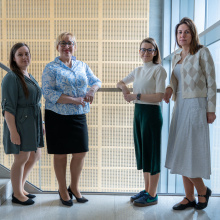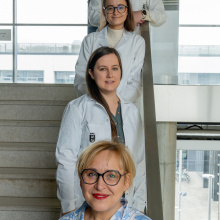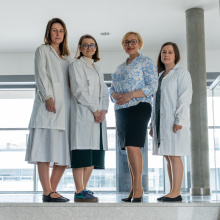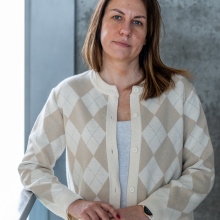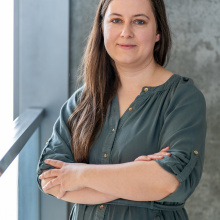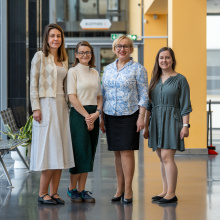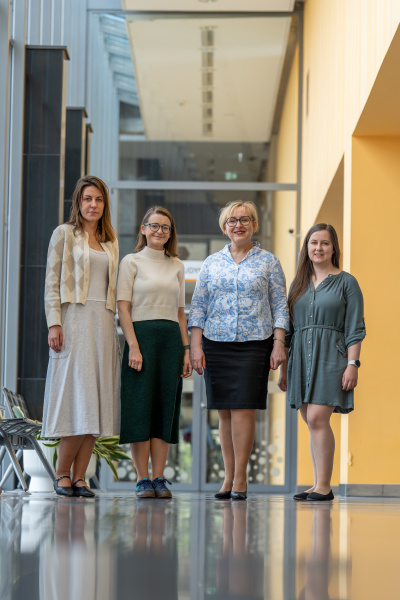
Photo by M. Byczkowski
An ageing population and lifestyle diseases such as osteoporosis and cancer are causing a steady increase in the number of patients suffering from bone fractures and diseases. There is therefore a growing need to find a remedy for such damage. Innovative biomaterials developed with the participation of a team of scientists from the Faculty of Chemistry at the University of Gdańsk may be the answer to these challenges. The invention entitled ‘Multifunctional composite implant materials for bone defect filling and bone tissue regeneration’ has recently been granted European patent protection.
The invention is the result of the work of an interdisciplinary team of researchers from several centres. On behalf of the University of Gdańsk, prof. Sylwia Rodziewicz-Motowidło (head of the Department of Biomedical Chemistry at the Faculty of Chemistry, University of Gdańsk) participated in the work together with a team consisting of prof. Franciszek Kasprzykowski, dr Justyna Sawicka, dr Natalia Karska and mgr Agnieszka Kubiś. The project also involved scientists from the Łukasiewicz Research Network Institute of Ceramics and Building Materials, the Wrocław University of Technology, the Institute of Biotechnology and Molecular Medicine, and representatives of SENS DX.
From an idea to a patent
‘The idea for a joint project was born during the Bioinnowacje conference in Gdańsk, where I met dr Artur Oziębło from the Institute of Ceramics and Building Materials,’ says prof. Sylwia Rodziewicz-Motowidło. ‘He was looking for teams to collaborate with. Together, we visited the World Hearing Centre in Kajetany, where we talked with prof. Piotr Skarżyński about the need for biomaterials for patients after hearing surgery. These meetings inspired us to create a concept for a new biomaterial. We formed an interdisciplinary team and submitted an application for funding to the National Centre for Research and Development. We received it in the TECHMATSTRATEG competition, and thus began the GlassPoPep project.’
According to prof. S. Rodziewicz-Motowidło, work on the invention involved numerous challenges: ‘The work took about four years and coincided with the pandemic, which made it somewhat difficult to carry out. The project involved several key stages: selecting the biocomposite components, forming the final biomaterials and testing them - biological in vitro and in vivo tests, as well as toxicity and sterilisability assessments. Despite the challenges, the objectives were achieved and very promising results were obtained.’
The scientists' efforts resulted in a patent granted by the European Patent Office (EPO) for the invention of ‘Multifunctional composite implant materials for bone defect filling and bone tissue regeneration’.
What is the invention?
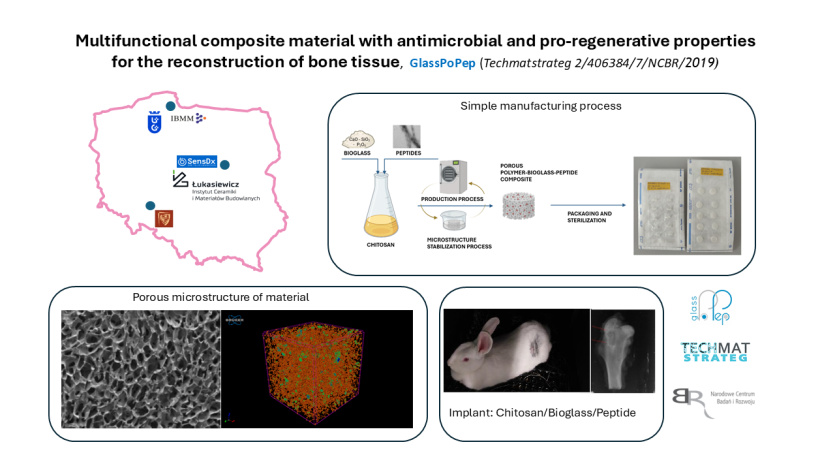
The newly developed composite implant materials - biomaterials - can be used in orthopaedics, maxillofacial surgery, neurosurgery and in operations performed after bone injuries. They have been developed using the latest advances in advanced materials engineering and biomedical chemistry. Their unique composition and formula support bone growth and the regeneration of damaged tissues. The materials include: chitosan - a natural polymer with high biocompatibility, bioactive glass and peptides.
The innovative composites also have antibacterial and pro-regenerative properties, which accelerate the healing process and reduce the number of post-operative complications in surgery and microsurgery. The biomaterials have been developed to additionally inhibit the growth of harmful microorganisms such as Staphylococcus aureus and Pseudomonas aeruginosa.
Innovative materials can also serve as carriers for other active substances (e.g. antibiotics)and provide a scaffold for cells during cell therapy.
‘Our biomaterial has a simple composition but unique biological properties - it supports bone cell influx, mineralisation and bone tissue reconstruction, while at the same time being biodegradable and replaced by newly formed bone,’ explains Prof. S. Rodziewicz-Motowidło. This has been confirmed by animal studies. In addition, the material is flexible and can be cut by the surgeon directly during surgery, which facilitates its clinical application.’
The patent confirms the innovative potential of the University of Gdańsk and its contribution to the development of biomedical technologies on an international scale. The project was financed by the National Centre for Research and Development as part of the GlassPoPep project (Techmatstrateg 2/406384/7/NCBR/2019).
The process of preparing the patent application to the EPO was coordinated by the Technology Transfer Office of the University of Gdańsk.

